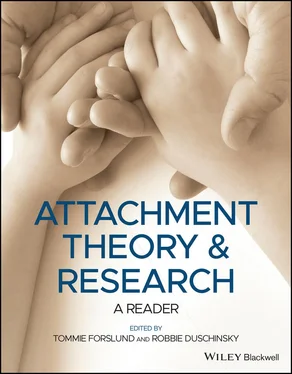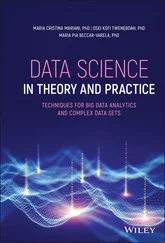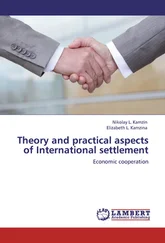16 16In his experiments with goat kids Liddell (1950) has demonstrated the very different responses to fright‐evoking stimuli of identical twins according to whether or not they were with their mother: the twin with his mother roamed about naturally and seemed relaxed, whereas the one without his mother froze almost immobile in a corner of the room.
17 17Of Schaffer’s twenty‐five subjects, sixteen were aged over 28 weeks and nine 28 weeks and under. Of the two younger infants who deviated from the usual behaviour, one was already 28 weeks of age, and so on the margin of the older age group, and the other was thought to be missing his dummy.
18 18Anthony writes: ‘It would also follow that before the seventh month the infant cannot be separated from an object‐mother firmly and substantially localized in space, as an organized reality. His separation feeling must therefore lack the quality of separations at a later stage.’
19 19See, for instance, Winnicott’s (1953) conception of the development of the false self and Balint’s (1952) of conditions which give rise to neurosis and the need for a ‘new beginning’.
20 20Analytic literature is full of references to hatred arising in such situations. That separation from mother itself provokes it has been used by Freud (1920, p. 16) as a possible explanation of the cotton‐reel incident: ‘Throwing away the object so that it was “gone”, ‘he suggests, ‘might satisfy an impulse of the child’s … to revenge himself on his mother for going away from him’. Dorothy Burlingham and Anna Freud (1944), Spitz (1953), Robertson (1953a, 1953b) and Heinicke (1956) have all reported first‐hand observations of intensely hostile behaviour following separation. It is Fairbairn’s ([1951] 1952) view that the origin of the infant’s aggression towards his libidinal object, and therefore of his ambivalence, lies in the trauma of separation from mother and the consequent libidinal deprivation and frustration.
21 21There is another situation which may lead a child to become excessively clinging and which may also masquerade as “spoiling.” It is when a mother, for unconscious reasons of her own, communicates to a child her desire that he should not leave her. This is a common finding in cases of so‐called school phobia (Johnson et al. 1941).
22 22In a comparison of twenty 6‐year‐old children reported as overdependent with twenty controls, Stendler (1954) found that six of the over‐dependent children were ‘over‐protected’ and eleven had suffered major disturbances in their lives between the ages of 9 months and 3 years.
2 Anxiety, Stress, and Homeostasis
John Bowlby
From the John Bowlby Archive, Wellcome Collections London, PP/Bow/H10
This paper was transcribed by Tommie Forslund and Robbie Duschinsky from John Bowlby’s notes. Some of the text had already been written on a typewriter by Bowlby, but most was in the form of handwritten notes, with additions, deletions, rewordings, and various footnotes suggesting rounds of reworking the text .
The thesis of this essay is that, in order to understand the conditions that elicit anxiety and fear, it is necessary first to consider basic biological principles. The principles concern (a) the nature of the states held relatively steady by a living organism (categories of homeostasis), and (b) the nature of the stable pathways along which development usually proceeds (categories of homeorhesis). Anxiety and fear are experienced, it is suggested, when some form of instability is appraised as being present or imminent and, especially, when instability is appraised as increasing and difficult to correct, or when risk of instability is appraised as increasing and difficult to reduce.
These appraisal processes, like any others, may or may not reach a phase of being felt. Because traditionally the words ‘anxiety’ and ‘fear’ refer to something felt, it is thought wisest to restrict their use to occasions when appraisal processes actually reach the phase of being felt. The term ‘unconscious anxiety’, though somewhat contradictory, is of course in common use. If used, it would apply to those same appraisal processes when they are in a phase of not being felt.
In order to survive in any environment, especially those undergoing changes, large or small, living organisms must maintain themselves in a comparatively steady state. Such steady state can be measured along numerous parameters, which can be grouped into a few major categories of homeostasis. Some refer to the organism’s interior state, some to its relation with the outside world.
The category of homeostasis first described by Claude Bernard, and for which Walter Cannon (1932) 1 coined the term, concerns a set of physiochemical measures interior to the organism. This category can be termed physiological homeostasis. Another set of measures also interior to the organism that are usually held even steadier, by healing processes, are those relating to body structure: this category can be termed morphological homeostasis. A third set of measures also held steady is well recognised by field biologists, namely the tendency for animals of any one species to remain within the limited range of environmental conditions to which the species is adapted – its ecological niche. Maintenance of an animal within its ecological niche is effected by a variety of behaviour patterns, the activation of which are sensitive to features of the environment. This category can be termed ecological homeostasis.
These three categories apply to all species of animal, and the first two apply also to plants. The biological control systems that maintain these categories of homeostasis are, for morphological homeostasis, physiological systems; for ecological homeostasis, behavioural systems; and for physiological homeostasis, both physiological and behavioural systems.
These three categories of homeostasis are intimately linked: by maintaining an animal within its ecological niche, the behavioural systems maintaining ecological homeostasis are acting in ways that greatly facilitate maintenance of morphological and physiological homeostasis.
I believe that at least two other categories of homeostasis can be recognised; they become increasingly evident in the higher animal phyla and play a great part in the lives of higher vertebrates and man. One of these categories refers to a special aspect of the organism’s interior state, the other to a special aspect of its relation to the environment. We start with the latter.
Individuals of a species do not roam at random throughout the whole area of ecologically suitable terrain. On the contrary, they usually spend the whole of their lives within an extremely restricted segment of it. For example, a vole lives within a few square yards of thicket, a troop of baboons within a few square miles of prairie, human hunters and gatherers within a few hundred square miles of forest or plain. Even migrating birds, which may travel thousands of miles between nesting and wintering grounds, use only special parts of each; many nest each year at or very near the place they were born.
Nor do animals of higher species mix indiscriminately with others of their kind. Individual recognition is the rule. With certain individuals close bonds may be maintained for long stretches of the life‐cycle. With a number of others there may be a less close but sustained relationship. Other animals may either be of little interest or else be carefully avoided.
Maintenance of an animal within that particular part of the ecological environment which it happens to frequent and in proximity to those particular individuals of its species with which it happens to associate I propose to term personal‐environmental homeostasis. 2 Ethological evidence shows that preferences of personal companions and of environment usually develop early in life and are mediated by learning processes of an imprinting kind. In general, whatever is familiar is preferred to whatever is strange.
Читать дальше












